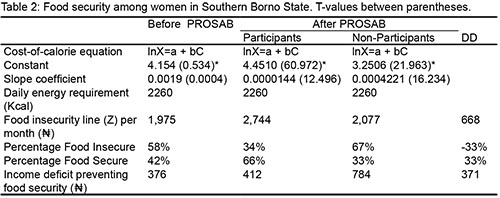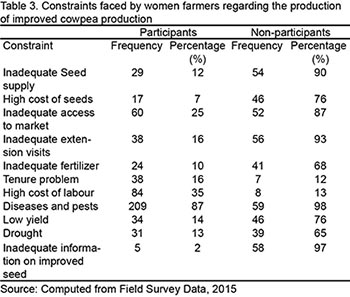I study the impact of improved cowpea varieties on women farmers in the Southern Part of Borno State, Nigeria. These technologies were introduced by the Promoting Sustainable Agriculture in Borno State, (PROSAB) project which was operative from 2004 to 2009. The specific objectives of this study were to identify the changes in income of women farmers as a result of using improved cowpea varieties, to analyse the impact of the improved technology on the food security status of women farmers and to identify constraints associated with the use of improved cowpea varieties.
Primary data were collected by means of structured questionnaires administered to 240 randomly-selected women farmers who participated in the PROSAB project and also planted the improved cowpea introduced (participants) and 60 farmers who did not participate (non-participants), giving a total of 300 respondents. Secondary data used came from a baseline survey conducted when the PROSAB project was implemented in 2004. The double difference (DD), the cost-of-calorie index and descriptive statistics were used to analyze all data. The DD is the difference between the income of both the participants and non-participants before implementation of the PROSAB project (2004) and after the project had ended (the project ended in 2009 and this study was conducted in 2015).
| The results showed that the use of improved cowpea varieties had a positive impact on income (Table 1). The annual income of the participants increased by ₦143,495 ($725), whereas the income of non-participants increased by only ₦58,500 ($295). |  |
The increase in the income of non-participants was a result of a spill-over effect from those who adopted the improved cowpea technology.
| The food insecurity line, Z – the costs of acquiring minimum energy requirements of 2260 Kcal per adult equivalent (FAO, 2009) – was determined at ₦1,975 per month before PROSAB. This rendered 58% of the households food insecure and 42% food secure. The deficit in aggregate income of food-insecure households was ₦376 (Table 2). |  |
For participants, the food insecurity line was determined at ₦2,744 per month after PROSAB. Of the participants, 34% was food insecure and 66% was food secure. This implies that food insecurity among the participants could have been reduced as a result of the PROSAB intervention. This implies that food insecurity among the participants could have been reduced as a result of the PROSAB intervention.
|
An extra ₦412 was required by food insecure participants to become food secure. The food insecurity line of non-participants was ₦2,077 per month after PROSAB. Two-thirds of them were food insecure and required an additional ₦784 to meet their basic food needs. The DD indicated a positive difference of ₦667 in the food security line of participants compared to non-participants. This shows that the improved cowpea technology had a positive impact on the food security of the respondents. The women cowpea farmers were constrained by various factors like diseases and pests, high costs of labour, lack of seeds of the new varieties, inadequate information and inadequate access to markets (Table 3). |
 |
It is recommended to formulate policies that encourage women farmers in the study area to adopt and sustain the use of improved varieties of cowpea. Improved cowpea varieties and other inputs should be made readily available and accessible to the women farmers at affordable prices, on time and in adequate quantities. The women farmers in the study area should be given adequate information on how to control pests and diseases. The women farmers’ access to extension services and their number of contacts with extension agents should be increased especially for the non-participants.
Binta Ali Zongoma, Department of Agricultrual Economics, University of Maiduguri, Nigeria (Click here for her 2016 update)
